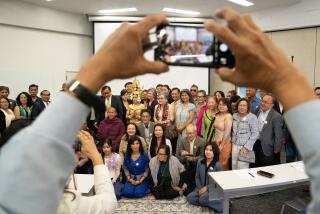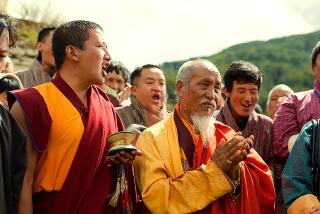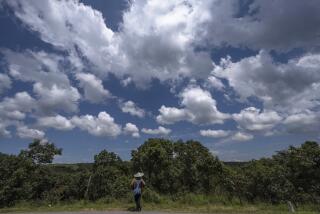Displaced People Find Haven in Their Hopes
SANGKHLABURI, Thailand â You wonât find it on maps or road signs, but on full moon nights, with a thousand lanterns flickering, Buddhist monks praying and sarong-clad women bearing offerings, one can almost believe that Monland lives in more than dreams.
The Bor Kamot-Kaban festival is one of many celebrated by 6,000 Mon people whose hillside home has proved a haven from the harsh military regime in nearby Myanmar and the not always welcoming Thais around them.
Living above a spectacular lake ringed by craggy limestone mountains, these heirs of one of Southeast Asiaâs great civilizations strive to preserve their language, traditions and even the dream of an independent homeland -- something that they last possessed 250 years ago.
Within Myanmar itself, about 1 million Mon live on uneasy terms with the junta that in 1995 negotiated a cease-fire with Mon insurgents who were among several ethnic movements waging struggles for independence.
âPeople were tired after 40 years of fighting. Homes were burned, fields destroyed, people were killed or disappeared. Now they are trying to re-establish their lives,â said Kasauh Mon of the Human Rights Foundation of Monland.
Some 100,000 Mon are thought to live in Thailand, descendants of those who fled upheavals in their homeland over the centuries. In recent times, sizable numbers have scattered from Australia to Fort Wayne, Ind.
Thai authorities forced 10,000 Mon refugees back into Myanmar during the 1990s, and most of those allowed to remain have been refused Thai citizenship. They even need special permission to leave Sangkhlaburi district, limiting chances for higher education. The Mon make do as fishermen, farmers and small traders.
But they have a home, thanks to a revered 94-year-old monk. When the old town of Sangkhlaburi was flooded in the 1980s by the rising waters behind the Khao Laem dam, Abbot Uttama obtained land for his people on the hill near the new town.
At the crown of the hill, the abbot constructed the resplendent Wang Wiwekaram Monastery as a repository of Mon culture. Donations poured in from many Thais who also regard him with great reverence.
âHeâs a good and intelligent leader for the Mon people. We donât see anybody to replace him. Itâs very sad,â Kasauh Mon said.
Through Uttamaâs efforts, youngsters learn the Mon language. Each year, he invites monks from Myanmar to give exams in Mon and Buddhist scriptures, awarding prizes to the best.
Activists in Sangkhlaburi have started a Mon Culture and Literature Survival Project, a news agency and Web site, and are investigating human rights abuses by Myanmarâs ruling military.
Although the junta denies the accusations, exiles have detailed arrests and torture, land confiscation, forced labor, and attempts to suppress Mon traditions. Splinter groups still battle Myanmarâs government despite the cease-fire, but the New Mon State Party, which made the peace deal, is allowed some authority over small areas in Mon State of southern Myanmar.
In Thailand, Mon cultural expression is allowed free rein, and festivals such as the Bor Kamot-Kaban are like ancient murals come to life. At night, to the shimmering tones of strings, cymbals and xylophones, mothers turn preteen daughters into little princesses of old, combing their long, shiny hair into garlanded topknots and rouging their lips.
The next morning, 16 dance in the vast monastery courtyard. The faithful fill a 45-foot canoe with rice, fruit and sweets, and float it on the lake in memory of an ancient monk who needed sustenance while meditating on a boat far out at sea.
Hundreds of people offer food to monks and prostrate themselves at the feet of Uttama, who sits at the top of a stairway to the monastery, using a whisk to sprinkle holy water on all who approach him in rituals observed by the Mon for a millennium. It was the Mon who spread the still-dominant Theravada Buddhism into Thailand, Cambodia and Myanmar, along with their own culture.
Politically, they flourished in Myanmar, previously known as Burma. Although their capital was sacked by the Burmese in the 11th century, captive Mon monks, craftsmen and architects shaped the wondrous capital of Pagan.
Mon power was regained, lost and finally broken in the mid-18th century when they became a people without a home.
More to Read
Sign up for Essential California
The most important California stories and recommendations in your inbox every morning.
You may occasionally receive promotional content from the Los Angeles Times.










